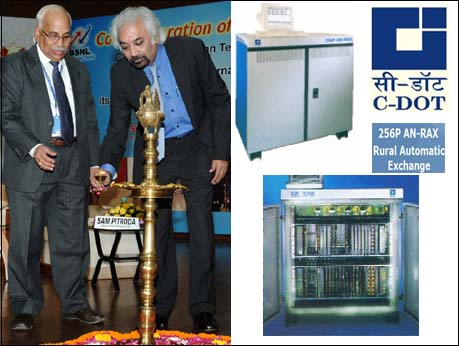
New Delhi, August 8, 2012: The Centre for Development of Telematics (C-DOT) -- the telecom technology development centre of the Government of India – celebrates the silver jubilee this week of the Rural Automatic Exchange (RAX), the product it developed a quarter century ago to kick-start India’s telecom revolution in the hinterland. It is 25 years since the first RAX exchange went live – on July 21 1986, in Kittur, Karnataka, near Belgaum. At simultaneous events to recall the historic landmark, in Ddelhi and Bangalore, C-DOT announced the imminent upgradation of the Kittue exchange to the next generation, Internet Protocol compliant MAX-NG exchange.
The Delhi event saw the participation of Dr Sam Pitroda, Adviser to the Prime Minister on Public Information Infrastructure, who was the original inspiration and first head of C-DOT. He said at the RAX jubilee function on Tuesday: “The first phase of the telecom revolution has ended. We have 900 million phones. The second part of telecom revolution is about to begin. This includes broadband networks connecting 2,50,000 panchayats through optical fibre aiming at transforming the economy”
adding “...“Focussing on indigenous development is the need of the hour. You cannot expect somebody from outside to build what you require”. ( link to quote report: http://www.thehindu.com/news/cities/bangalore/article3738976.ece ).
RAX appeared on the scene at a time when country’s telecom network was way under-developed. It was designed by C-DOT for Indian conditions of high ambient temperatures, dust and unreliable power. It required no air-conditioning. It was based on contemporary digital switching technology with microprocessor based controllers and had no moving parts, which gave it immunity against dust, the bane of electromechanical Strowger and Crossbar exchanges in India. Named 128 P RAX, it was a tiny 128-ports switch. It had only analogue trunks to connect it to a larger exchange in a nearby city. It could cater to a total of 80 subscribers and had 24 analogue trunks to connect to the city exchange. But in villages with practically no telephones, 80 was a big number. There must millions villagers who made or received their first ever call through C-DOT RAX. . RAX acquired a legendary status in no time at. It extended connectivity, including STD, ISD to rural areas. 26 manufacturers went into RAX production. RAX-a-day programme was started by DoT which grew to something like 32 RAXes a day. By March 1993, more than 10000 RAXes had been produced. Other developing countries evinced great interest in RAX and exports to Vietnam, Nepal and Bangladesh followed.The RAX was later upgraded to 256P, doubling its capacity.
C-DOT was founded in August 1984 as a registered Scientific Society of Government of India. It was the culmination of efforts of Sam Pitroda, a telecom wizard with over 55 patents to his credit and then a US based NRI, who convinced the then political leadership --Indira Gandhi and Rajiv Gandhi -- of the need of a home grown telecom technology, best suited to Indian conditions. Recognizing the vital importance of telecom to development and its many multiplier effects, the Government agreed to set up C-DOT with a mandate of developing indigenous telephone switch in 36 months with a budget of Rs 360 million.A core team was formed with 300 engineers from Department of Telecommunications and The Tata Institute of FundamentaI Research, with labs in Delhi and Bangalore. www.cdot.com